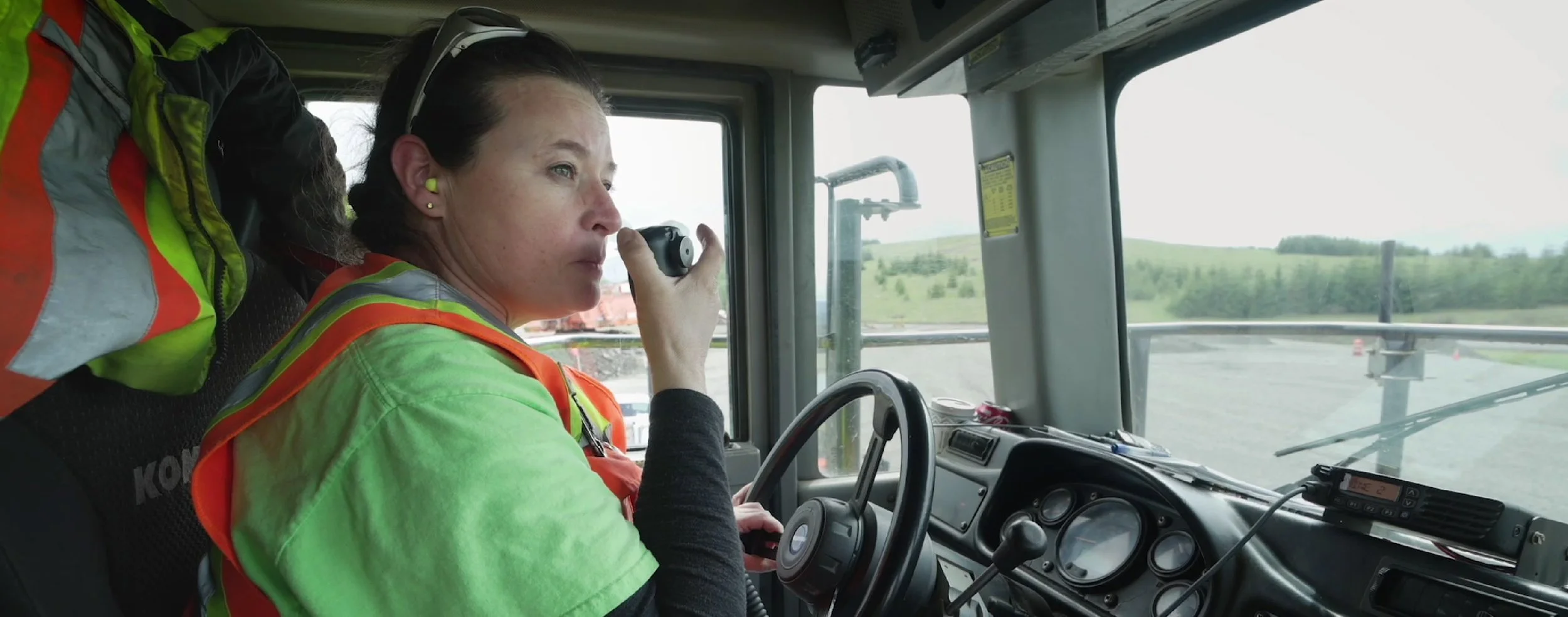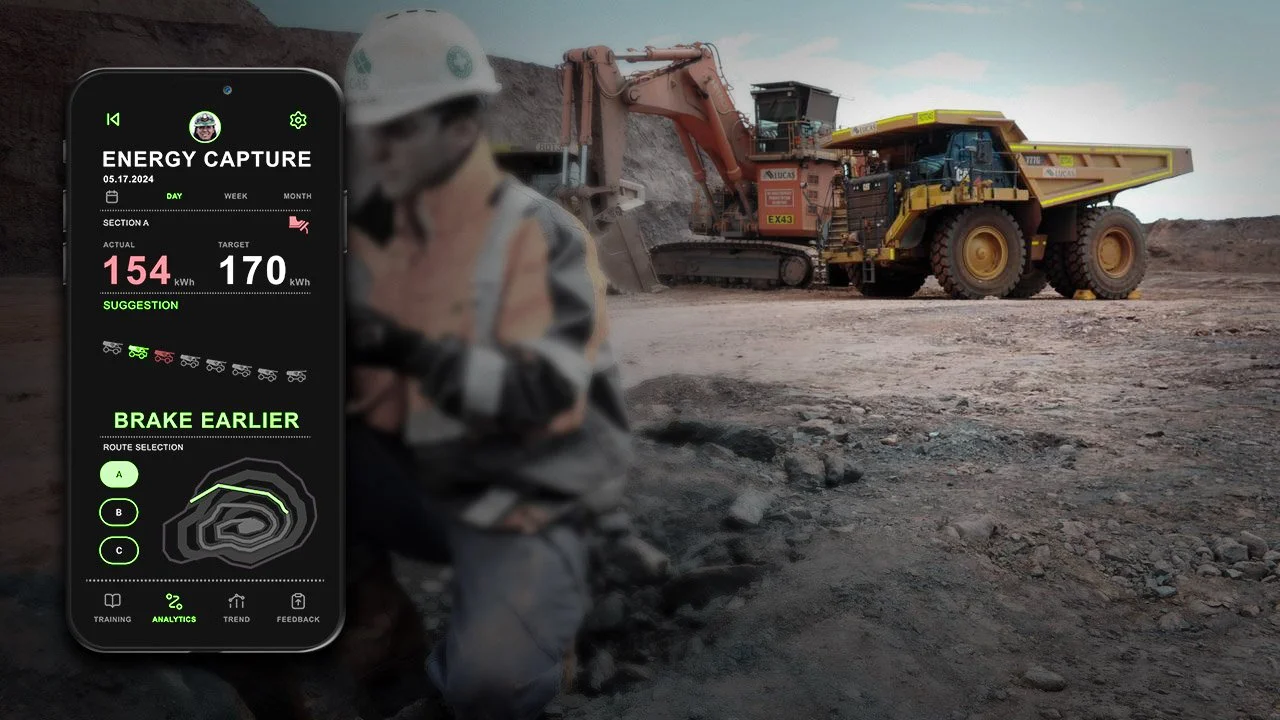TRAINING PROGRAM for DRIVERS
GENERATIVE RESEARCH & PRODUCT DEFINITION
SYNOPSIS
Driver Training for Hybrid Electric Truck Program
COMPANY / CLIENT
First Mode
ROLE
Lead User Researcher | UI Design Mockup
CROSS FUNCTIONAL TEAMS
Product Management | Software Product Development | Modeling & Simulation
First mode is an engineering product startup company aiming to decarbonize the mining industry. The approach is a hybrid diesel-electric program that converts existing diesel truck into hybrid electric vehicles. It does so by:
Capturing Electric Energy through regenerative braking - especially on downhill route portions.
The Captured Energy is then applied to assist the truck on uphill climbs, resulting in less Diesel Fuel consumption - thus Diesel Savings.
BACKGROUND
Video by ©Camille Woodthorpe
Because downhill energy is captured through Brake Application, optimizing Driver Brake behavior is critical to energy capture optimization.
PROBLEM STATEMENT
“What is the best way to retrain Driver Brake Behavior in order to optimize energy capture, resulting in less Diesel Consumption?”
CHALLENGES
Lacking holistic understanding of our target user, the Mine Truck Driver.
There is already inclination of implementing of a live, performance feedback monitor inside the driver cabin without first engaging with customer stakeholders.
“There is inclination towards implementing a user behavior Live-feedback monitor even though user-understanding of the Driver is limited.”
While drivers are a bit more accessible than mine leadership personnel, the user pool is still limited. To overcome the challenge, I applied the following mixed approach to combat it:
Set up 10 qualitative interviews mixed of 2 groups
4 users are active drivers
6 users are a mix of internal stakeholders and mine personnel from a nearby Washington Mine, both groups have part-time driving experience.
Composed first drafts of the following visual research collaterals in order to expedite user understanding of the research topics during interviews. I created these frameworks for the Junior Researcher to use as we collectively paint a more holistic picture of the Service Design experience.
RESEARCH METHODOLOGY & COLLATERAL
Goal of the Discovery Research should be to uncover the:
User's routines and contextual details related to their daily duties
Evaluate whether Live-Feedback Monitor is appropriate for the User
Understanding of how the truck’s brake system work
Be on the lookout for other potential approaches to brake energy capture optimization
-
Understand and empathize with the user, looking into typical traits & approaches to their responsibilities
Their context will help us understand how receptive & appropriate the various solutions are.
-
Visually outline the activities the User goes through.
Representation of Day | Week | Month in the life of User is like.
Provides conversation background to overlay various Hypothetical Solutions & simulate its effectiveness.
-
Illustrations help make brake application testing more understandable.
Start aligning with Modeling + Simulation on what things should be verified in the real world.
FINDINGS & ANALYSIS
FINDINGS 1
Driver’s taxing schedule severely hinders their mental capacity to learn new training material.
14 hour work days (shifts + commute) - only 45 min break total over 2 sessions
1 week day shifts, then immediate switch to 1 week night shift
1 week break, including flight travel home. Then 2 week shift starts again.
Consider instead a holistic program consisting of various interface appropriate for Driver’s mental receptiveness
Simplified feedback - between daily shifts
Comprehensive feedback - between weekly shifts
Simulator Training - between bi-weekly shifts (Existing 3rd Party Simulator Partnership)
FINDINGS 3
DETAILS
“Think of Driver Training not as any single approach, but as a holistic Driver’s Education program tailor-made to reflect Drivers’ mental capacity to retain knowledge.”
Reprogramming Automatic Brake Speed Control likely a better solution to optimize brake energy capture
Already part of existing driver interface
Removes potential user error
Development needs longer lead time and engineering efforts
FINDINGS 4
“Augmenting Automatic Brake Control is the best Long-term approach to optimize energy capture because we can leverage vehicle control computer while minimizing chance of user error.”
FINDINGS 2
Mine sponsored Neutral 3rd Party research found any additional interface / monitor will increase driving hazard; it distract drivers from driving operations.
“Given the overtly cluttered dashboard interface and the exhaustive shift schedule, Live-feedback monitor is not an appropriate training approach.”
IMPACT
CUSTOMER
Users feels appreciative that their needs and well-being are recognized. They can now learn & help the trial under healthy physical & mental conditions.
Corporate is appreciative that their safety studies and general consideration for employee safety is addressed.
PRODUCT MANAGEMENT
research provided both short term (user training) and long term (automated brake control) goals for the product roadmap ensuring we have the appropriate solutions for the various maturity stages of the solution program.
ENGINEERING
Identifying Long term goal of automated brake control at an early stage gives the engineering team for time for research and development.
Since so much additional insights was uncovered, I worked with the Product Manager to devise a product development roadmap and separated the action items into Immediate and Near-term Product User Research.
ACTION ITEMS
IMMEDIATE
Rethink Driver Behavior Change as a Holistic Training Program
Explore different methods at the appropriate timing:
Simplified feedback - between daily shifts
Comprehensive feedback - between weekly shifts
Simulator Training - between monthly shifts
NEAR-TERM
Start development of Automated Brake Control
Collaborative Research and development of Automated Brake Control between Engineering and Model + Simulation teams
The project began with internal stakeholders sure of the solution approach and wanting to jump right into design & development. Through research and bringing the end user context more into light, we were able to devise more appropriate solution approaches to continually develop & refine.








